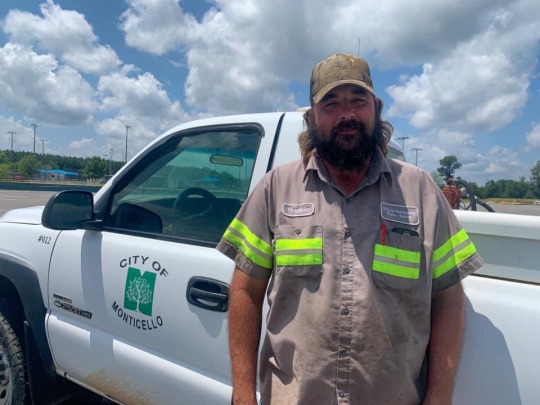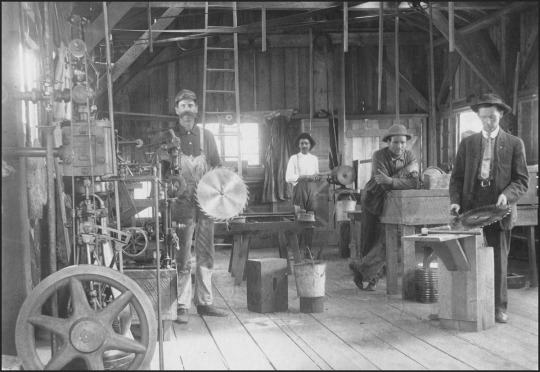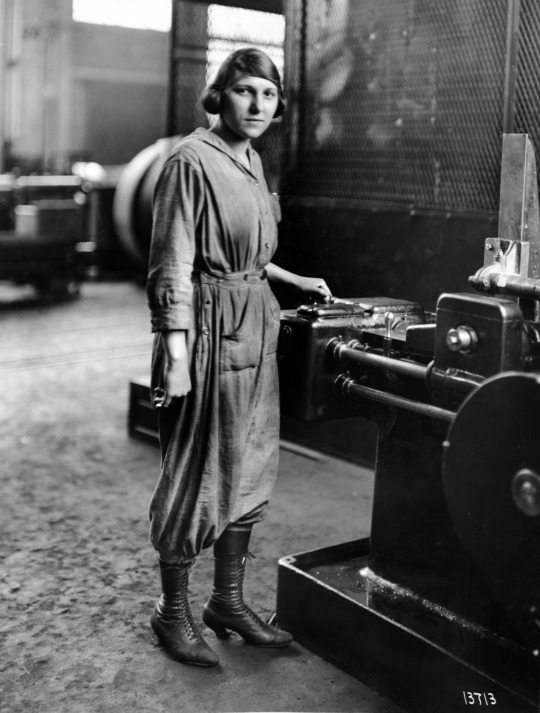#workerwednesday
Photo

Today’s #WorkerWednesday shows employees of the Joseph Bancroft & Sons Co. etching designs on textile rollers at the company’s Print Works Division in Eddystone, Pennsylvania.
This circa 1937 photograph is part of the Hagley Library’s collection of Joseph Bancroft and Sons Company photographs (Accession 1969.025). Joseph Bancroft, an Englishman trained in textile weaving in Lancashire, established his own cotton mill on the Brandywine near Wilmington, Delaware in 1831. The firm was incorporated as the Joseph Bancroft & Sons Company in 1889.
To view more material from this collection online now, click here to visit its page in our Digital Archive.
#WorkerWednesday#Worker Wednesday#textile industry#textile workers#textile history#textile design#women in the trades#women at work#women workers#Joseph Bancroft & Sons#Joseph Bancroft#Delaware history#Eddystone PA
201 notes
·
View notes
Photo

Happy Earth Day! From the 1970 Amalgamated Clothing Workers of America national convention. Photographer unknown. #Laborhistory #Unionactivism #Environmentalissues #Patriotism #KheelCenter #WorkerWednesday #CornellRAD #laborarchives #earthday https://www.instagram.com/p/CN-KyPOpTad/?igshid=aa8yqd6t6f97
#laborhistory#unionactivism#environmentalissues#patriotism#kheelcenter#workerwednesday#cornellrad#laborarchives#earthday
1 note
·
View note
Photo

Break time! #workerwednesday. Photo by @igiveashoot from 2017 #openingmoves. #clubloose #godrifting #greatestplaceonearth #listentoclubloose #suckingasandhaulinass #letsparty #letsshred #openingmovescountdown
#godrifting#letsparty#workerwednesday#listentoclubloose#openingmoves#suckingasandhaulinass#clubloose#openingmovescountdown#letsshred#greatestplaceonearth
40 notes
·
View notes
Video
You have no idea what happens at the Parks Finest. Behind the scenes they don't just serve amazing Food, but they serve some WatahhhhYattaaaaaa Ass Kicking too if need be! Hahaha loves these guys! . #Repost @theparksfinest with @repostapp ・・・ This Worker Wednesday we salute our resident black belt, Nacho. Here he is in our old kitchen set up showing off some kata moves. #LosAngeles #DTLA #EchoPark #Love #Local #BBQ #Craftbeer #blackbelt #kata #thebestaround #workerwednesday (at The Park's Finest)
#thebestaround#craftbeer#blackbelt#repost#losangeles#love#dtla#echopark#kata#local#workerwednesday#bbq
0 notes
Photo

City Of Monticello Arkansas Worker Wednesday Features Monticello Arkansas Firefighter Shawn Mooney #workerWednesday This week’s highlight is Shawn Maloney! Shawn has been with lived in Monticello for 33 years and worked for the Fire Department for 20 years.
0 notes
Text
@MDSHA: #WorkerWednesday MDOT SHA is looking for a Program Manager (Administrator I) https://t.co/8aIJmWkmEf sf #mdotnews https://t.co/jLhSJMcFkQ m.twitter....
0 notes
Photo

This #WorkerWednesday, we’re paying a visit to the staff of the furnace and cupola in the Westinghouse Machine Company’s Melting Department foundry at the South Philadelphia Works in Essington and Lester, Pennsylvania.
The Westinghouse Machine Company, which became the Westinghouse Electric Corporation in 1945, manufactured gas and steam engines, turbines and mechanical stokers for use in railway systems, fire service pumping stations, the shipping industry, and other large scale industrial purposes. These foundry workers were photographed by company photographer Charles Yessel on May 12, 1920 for the company’s newsletter, Machine News.
This image is part of Hagley Library’s collection of Westinghouse Electric Corporation Steam Division photographs (Accession 1969.170). A curated selection of items from this collection has been digitized; our Digital Archive offers over 1,000 photographs from this resource dating from 1898 to 1964. These photographs cover a variety of subjects including building construction, turbine manufacturing, research facilities, machinery, executives and employees, and visitors to the facility. To view more material from this collection online now, click here.
#WorkerWednesday#Worker Wednesday#foundries#foundry workers#iron and steel workers#Westinghouse Machine Company#Lester PA#Essington PA#Westinghouse Electric Corporation#Charles Yessel#1920s#WestinghouseWednesday#Westinghouse Wednesday#Great Migration#labor
38 notes
·
View notes
Text
It's Worker Wednesday.
Pierre makes $8 an hour, while the local living wage is $14.
In high cost areas like New York City, $8 an hour just isn’t enough to pay the bills, much less save for a brighter future.
Click here to tell Albany that it's time to let cities and counties set their own minimum wage, so people can make ends meet!

0 notes
Photo

#WorkerWednesday with just a few of the dudes that keep these events going. When you see these guys, or any of the other staff this weekend, say thanks or buy them a beer or just a simple high five. Photos by @sutphen91910 and @scott.hastings. #clubloose #godrifting #greatestplaceonearth #listentoclubloose #suckingasandhaulinass #enterdeathsrealm #letsparty #letsshred #EastCoastBash
#suckingasandhaulinass#letsparty#godrifting#enterdeathsrealm#clubloose#eastcoastbash#greatestplaceonearth#workerwednesday#listentoclubloose#letsshred
0 notes
Text
City Of Monticello Arkansas Worker Wednesday Features Franklin Maddox Public Works Dickson 20 years
City Of Monticello Arkansas Worker Wednesday Features Franklin Maddox Public Works Dickson 20 years


workerWednesday
This week’s highlight is Franklin Maddox!
Franklin has been in our Public Works division for 20 years and is a lifelong resident of Drew County. His favorite part of his job is being a part of a team and accomplishing projects. Franklin has been married for 17 years and has two sons. In his off time, he loves to hunt and fish.
We appreciate all of your hard work and…
View On WordPress
0 notes
Photo

Today’s #WorkerWednesday photo dates to around 1945, and shows an operator cleaning scale from a zinc roaster during an early stage in the sulfuric acid manufacturing process at the East Chicago works of DuPont's Grasselli Chemicals Department plant.
Sulfuric acid is and was used by manufacturers of fertilizer, petroleum, textile, iron and steel, paint and pigment, chemical, explosives and other industries.In the process seen here, finely ground zinc sulfide ore is blown into the roaster, where it is burned with air to produce sulfur dioxide and zinc oxide. The zinc oxide was be reduced to zinc metal and the sulfur dioxide was converted into sulfuric acid by either contact or chamber process.
This photograph is part of Hagley Library’s collection of DuPont Company Product Information photographs (Accession 1972.341). To see more material from this collection online now, click here to visit its page in our Digital Archive.
#Worker Wednesday#WorkerWednesday#DuPont#better things for better living#1940s#manufacturing process#chemical industry#sulfuric acid#chemical workers#black people in the trades#zinc roaster#East Chicago#Chicago history#Indiana history#industrial labor
60 notes
·
View notes
Photo

This #WorkerWednesday, we’re making a visit to the Camphor Plant of E.I. du Pont de Nemours & Company’s Chambers Works facility.
The site, located on the Delaware River in Deepwater Point, New Jersey, was established by the DuPont Company in 1892 for the purpose of manufacturing gunpowder. Between then and when it closed in 2018, the site was used to develop, manufacture, and store a wide variety of chemical products, including Kevlar, nylon, Freon, leaded gasoline, and uranium processing for the Manhattan Project.
Camphor, an aromatic compound produced from the wood of camphor producing plants, or synthetically derived from turpentine, is a versatile product used in mothballs, embalming fluids, perfumes, medicinal products and, in the early years of the plastics industry, as a plasticizer used in the manufacturing of celluloid and plastic lacquers.
This ca. 1945 photograph is part of Hagley Library’s collection of DuPont Company Product Information photographs (Accession 1972.341). The DuPont Company created the Product Information section within the Public Relations department in 1952. Its function was to produce news releases with photographs about DuPont and its products for indirect publicity and advertising purposes.
This collection contains photographs of DuPont Company corporate events and proceedings, product trade shows and fairs, development and manufacturing processes, and the employees and facilities where the products were created. Most of the photographs were taken from the 1930s through the 1950s. This collection has not been digitized in its entirety, but you can view a selection of images online now. Just click here to visit its page in our Digital Archive.
#Worker Wednesday#WorkerWednesday#DuPont#Deepwater Point NJ#chemical industry#Chambers Works#camphor#women in the trades#women at work#chemical workers#industrial production#New Jersey#New Jersey history#plastic industry#plastics#plastic
15 notes
·
View notes
Photo

Today’s #WorkerWednesday post brings us inside the tool room of the Hoopes Brothers & Darlington sawmill in Brooksville, Florida. A note on the reverse of this ca. 1907 photograph identifies the person on the far right as Frank Orville Reagan (1869-1937), the son of Owen Wily Reagan (1847-1909), the sawmill’s manager.
The company that owned the mill, Hoopes Brothers & Darlington, began in West Chester, Pennsylvania in 1867 as a manufacturer of wooden spokes for wheels. By the 1880s it had become one of the largest wooden wheel makers in the United States, with mills and timber harvesting operations established throughout the southern United States.
The mill seen here was established in 1906. Hoopes Brothers & Darlington had originally established their Florida operations in nearby Ocala in 1899, but relocated after exhausting local timber supplies and to take advantage of cheaper railroad freight rates. Owen Wiley Reagan had also managed the Ocala mill, with his son Frank working as assistant manager. After his father’s death in November 1909, Frank took over operations of the Brooksville mill.
This photograph is part of Hagley Library’s collection of Hoopes Brothers & Darlington, Inc. photographs (Accession 1969.099). This collection consists of miscellaneous images from the company, largely dating between 1900 and 1948, as well as advertising material and letterheads. To view the collection online now in our Digital Archive, click here.
#Worker Wednesday#WorkerWednesday#Hoopes Brothers & Darlington#sawill#sawmills#timber industry#Brooksville Florida#Florida history#Frank Orville Reagan#Owen Wiley Reagan#West Chester Pennsylvania#wooden wheel#wheelmakers#woodworking#1900s#tool room#woodworking industry
16 notes
·
View notes
Photo

In the 1920′s, building on the success of the government’s WWI poster campaign and, in response to the labor struggles of the time, Mather & Company created a series of workplace posters marketed towards employers. From 1923 to 1929, businesses that subscribed to the Chicago, Illinois company’s workplace poster program received a new poster every week.
To view more posters from the Hagley Library’s collections of Mather & Company work incentive posters (Accession 2005.278), click here to see their inclusion in our Digital Archive’s collection of workplace posters in the United States.
#Mather & Company#Mather & Co.#workplace poster#employee morale#1920s#1920s style#1920s illustration#criticism#workers#WorkerWednesday#worker wednesday#employee motivation#motivational poster
46 notes
·
View notes
Photo

This #WorkerWednesday, we’re stopping in to visit Marie Wychunus, who worked as an operator on a gear cutting machine at the South Philadelphia Works of the Westinghouse Electric & Manufacturing Company. This photograph of her was taken by staff photographer Charles Yessel (1877-1953) on May 6, 1919 for publication in the company’s newspaper, Machine News.
This image is part of Hagley Library’s collection of Westinghouse Electric Corporation Steam Division photographs (Accession 1969.170). This collection has not been digitized in its entirety, but our Digital Archive does feature over 1,000 photographs from it, dating from 1898 to 1964. These photographs cover a variety of subjects including building construction, turbine manufacturing, research facilities, machinery, executives and employees, and visitors to the facility in eastern Pennsylvania. To view more material from this collection online now, click here.
#Worker Wednesday#WorkerWednesday#Westinghouse#Philadelphia#WestinghouseWednesday#Westinghouse Electric & Manufacturing Company#Charles Yessel#Marie Wychunus#women at work#women in the trades#1910s
16 notes
·
View notes
Photo

This #WorkerWednesday, we’re sharing a group photo of the community of Mexican employees at the Old Hickory munitions plant in Tennessee. This image was captured on this date, September 2, in 1918.
At the time this photograph was taken, Old Hickory was new, having recently been constructed to manufacture munitions for World War I. The workers seen here would have lived and worked on site, in the 3,867 buildings that made up the industrial footprint of the plant, and in the additional buildings of the workers’ village, which housed the plant’s approximately 35,000 workers and their families.
The plant was a built and operated by DuPont in 1918, and funded by a contract with the United States government to manufacture gunpowder for World War I. At its peak, the plant covered 4,700 acres, employed as many as 56,000 men and women, and produced half a million pounds of gunpowder a day. Many of the workers at Old Hickory lived on site in temporary and permanent housing, and DuPont constructed schools, churches, stores, banks, theaters, a hospital, restaurants, a fire hall, a hotel, and other facilities to meet the needs of this population. Both the housing and public amenities at Old Hickory were racially segregated.
Following the end of World War I in November 1918, DuPont ceased production at the site, with operations closing down entirely by early 1919. Following a sale to the Nashville Industrial Corporation in 1920, DuPont would later repurchase the plant in 1923 and use it as a manufacturing site for rayon and cellophane.
This photograph is part of the Hagley Library’s DuPont Company Museum collection (Accession 1968.001). This collection consists of photographs and prints that document the history of the DuPont Company. The materials in this collection were originally compiled by the DuPont Company Museum, transferred to the Hagley Museum in 1954 and subsequently to the Hagley Library in 1968.
Among other subjects, the image depict the 1901 Pan-American Exposition in Buffalo, New York; the construction of Coleman du Pont Road; production of Phenolin; game birds advertising series; Haskwell Works explosion aftermath, cartoons of employees; a female employee baseball league; and company plants at Old Hickory, Tennessee and Farmingdale, New Jersey.
The collection has not been digitized in its entirety, but to view a curated selection of items, you can click here to visit its page in our Digital Archive.
#Old Hickory#Worker Wednesday#WorkerWednesday#1910s#OTD#on this date#on this day#DuPont#WWI#WWI Wednesday#World War I#munitions plant#defense industry#Mexican-American#Mexican#Latinx#Tennessee#Tennessee history#labor history
38 notes
·
View notes